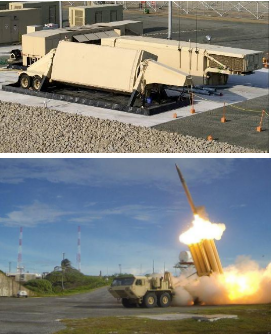The Significance of THAAD in Northeast Asia
The two components of THAAD:the X-band radar (above) [Source: defenseindustrydaily.com] and missile interceptors (below) [Source: guampdn.com]
On Aug. 16, the World Current Report’s chief editor interviewed Lee Jeong-chul, a professor at Soongsil University and ISC adviser on his thoughts about THAAD deployment in South Korea and its political impact in the region.
China’s opposition The United States and South Korea claim that THAAD deployment in South Korea has to do with detecting and intercepting North Korean missiles, and that it has nothing to do with China. Professor Lee explains that China’s opposition is not the missile-intercepting portion of THAAD but rather its missile-detecting radar component, what is commonly referred to as the X-band radar, officially AN/TPY-2. That’s because the X-band radar has two modes of detection: a longer (forward-based mode) and shorter (terminal-mode) range. Intercepting antiballistic missiles in their terminal phase (i.e. as they are coming down on the target) which THAAD is purportedly meant to do involves the shorter (terminal-mode) range. In this terminal mode, the radar’s detection range is 600 kilometers (about 370 miles). The United States and South Korea claim that since this range falls within the Korean Peninsula, China has nothing to concern itself with in these manners. The problem is that the X-band radar can be switched to the longer forward-base mode that can cover 2,000 to 3,000 kilometers. This would cover most of Northeast Asia. “The hardware is the same; it would simply be about switching the software from one mode to the other,” Professor Lee explains. “This only takes three to four hours.” Thus, if a conflict were to break out with China, the United States could easily switch to the longer-range detection mode, thus extending the radar detecting ability of the US missile defense system to cover most of Northeast Asia. This would give the United States great advantage in a conflict against China by effectively neutralizing China’s missile system.
North Korea as specter Not only that, but THAAD’s actual ability to intercept missiles from North Korea would be very limited. That’s because THAAD is effective against missiles launched at a high altitude. Yet, the short distance between North Korea and the Seoul metropolitan region – which contains almost 50 percent of the population - means North Korea would most likely use a low-altitude missile if it were to attack this area. In this most destructive of scenarios, THAAD would be irrelevant, dealing a strong blow to the argument that THAAD is meant to address the North Korean threat.
China’s pressure on the Park government “China likes to show itself as observing the rules of global norms,” Lee says. Yet, this is true in form only, as China’s exertion of power is discretionary, free from the gaze of other countries. In fact, it is this informal relationship that is “regarded as more important nowadays.” Lee predicts that China will unofficially sanction South Korea’s cosmetics industry and tourism. “For example, they can impose an unofficial tax barrier such as making the customs process longer,” he says. South Korean tourism can likewise be hurt by China making it more cumbersome or difficult for its people to travel to Korea. As Chinese tourists to South Korea make up 15 trillion won (around 13 billion U.S. dollars) of South Korea’s 1,500 trillion won GDP (around 1.3 trillion US dollars), a decreasing number of Chinese tourists to South Korea would be significant. Lee explains how Taiwan has experienced a recent decrease in travelers from China for no particular reason. In this manner, China exerts its power discreetly so that only the target country notices and gets the message.
North Korea, China, and Russia In addition to triggering strong opposition from China, THAAD deployment also impacts Northeast Asia’s geopolitical balance. After the decision to deploy THAAD in South Korea was announced, North Korea responded by threatening to take “physical action.” On July 21, they followed through by launching a missile that landed 155 miles off the northern coast of Japan. On Aug. 3, China blocked a U.S.-backed United Nations Security Council resolution condemning the attack. Recently, with North Korea’s successful test on Aug. 24 of a submarine-launched ballistic missile, China finally joined the UN resolution against North Korea. Lee explains that China picks and chooses which UN resolutions against North Korea it will support, and those are often against nuclear tests and long-range missile launches. Given its impact on the region, the Aug. 24 submarine-launched ballistic missile test would fall under this latter group. Even if North Korea’s ground-based missile defense systems were taken out, it would still be able to launch missiles from a hidden submarine at sea. According to Lee, the relationship between China and North Korea is ultimately not one of allies but rather, one in which “China utilizes North Korea.” Instead of THAAD drawing China and North Korea closer together, Lee notes that it is probably bringing China and Russia, who have historically been at odds with each other, into an alliance.
Future of THAAD Lee is pessimistic about stopping THAAD because it is part of the conservatives’ pro-U.S. strategy. Yet, the liberals do not offer a fundamentally different stance. “As you know, Moon Jae-In [a possible contender for the liberal nomination for president next year], is very careful to speak out against THAAD,” Lee says. The lawmaker fears a backlash from both the United States and the part of the public supporting THAAD. Lee likens Moon to former President Roh Moo-hyun, under whom Moon served as chief of staff, in that Roh “always talked about independence from the United States, but his real policy was very conservative and pro-U.S.” Thus, Lee has “no expectations for Moon Jae-n and the opposition parties’ ability to oppose THAAD.”

